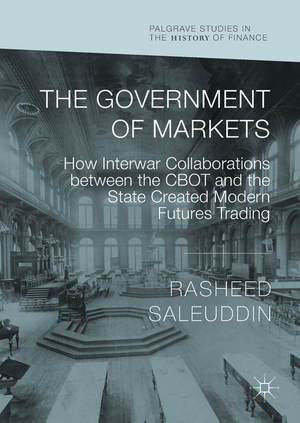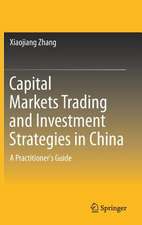The Government of Markets: How Interwar Collaborations between the CBOT and the State Created Modern Futures Trading: Palgrave Studies in the History of Finance
Autor Rasheed Saleuddinen Limba Engleză Hardback – 14 ian 2019
Din seria Palgrave Studies in the History of Finance
-
 Preț: 362.11 lei
Preț: 362.11 lei - 9%
 Preț: 764.94 lei
Preț: 764.94 lei - 9%
 Preț: 626.30 lei
Preț: 626.30 lei - 18%
 Preț: 737.26 lei
Preț: 737.26 lei - 15%
 Preț: 522.89 lei
Preț: 522.89 lei -
 Preț: 451.65 lei
Preț: 451.65 lei - 15%
 Preț: 701.06 lei
Preț: 701.06 lei - 18%
 Preț: 726.37 lei
Preț: 726.37 lei - 15%
 Preț: 712.22 lei
Preț: 712.22 lei - 15%
 Preț: 530.25 lei
Preț: 530.25 lei - 18%
 Preț: 1114.21 lei
Preț: 1114.21 lei - 18%
 Preț: 1006.55 lei
Preț: 1006.55 lei - 18%
 Preț: 726.06 lei
Preț: 726.06 lei - 18%
 Preț: 786.84 lei
Preț: 786.84 lei - 18%
 Preț: 792.03 lei
Preț: 792.03 lei - 18%
 Preț: 724.94 lei
Preț: 724.94 lei - 15%
 Preț: 702.54 lei
Preț: 702.54 lei - 18%
 Preț: 723.69 lei
Preț: 723.69 lei -
 Preț: 388.72 lei
Preț: 388.72 lei - 15%
 Preț: 694.19 lei
Preț: 694.19 lei - 18%
 Preț: 782.72 lei
Preț: 782.72 lei - 15%
 Preț: 637.59 lei
Preț: 637.59 lei - 18%
 Preț: 1108.51 lei
Preț: 1108.51 lei - 9%
 Preț: 920.31 lei
Preț: 920.31 lei - 15%
 Preț: 711.89 lei
Preț: 711.89 lei -
 Preț: 383.12 lei
Preț: 383.12 lei - 18%
 Preț: 891.33 lei
Preț: 891.33 lei - 18%
 Preț: 958.25 lei
Preț: 958.25 lei - 18%
 Preț: 1008.28 lei
Preț: 1008.28 lei -
 Preț: 445.88 lei
Preț: 445.88 lei - 18%
 Preț: 1113.58 lei
Preț: 1113.58 lei - 15%
 Preț: 646.75 lei
Preț: 646.75 lei -
 Preț: 450.11 lei
Preț: 450.11 lei - 18%
 Preț: 794.39 lei
Preț: 794.39 lei - 18%
 Preț: 948.29 lei
Preț: 948.29 lei - 15%
 Preț: 697.97 lei
Preț: 697.97 lei - 18%
 Preț: 728.74 lei
Preț: 728.74 lei
Preț: 702.05 lei
Preț vechi: 825.94 lei
-15% Nou
Puncte Express: 1053
Preț estimativ în valută:
134.33€ • 140.27$ • 110.93£
134.33€ • 140.27$ • 110.93£
Carte tipărită la comandă
Livrare economică 15-29 aprilie
Preluare comenzi: 021 569.72.76
Specificații
ISBN-13: 9783319931838
ISBN-10: 3319931830
Pagini: 306
Ilustrații: XIX, 321 p. 5 illus., 1 illus. in color.
Dimensiuni: 148 x 210 mm
Greutate: 0.56 kg
Ediția:1st ed. 2018
Editura: Springer International Publishing
Colecția Palgrave Macmillan
Seria Palgrave Studies in the History of Finance
Locul publicării:Cham, Switzerland
ISBN-10: 3319931830
Pagini: 306
Ilustrații: XIX, 321 p. 5 illus., 1 illus. in color.
Dimensiuni: 148 x 210 mm
Greutate: 0.56 kg
Ediția:1st ed. 2018
Editura: Springer International Publishing
Colecția Palgrave Macmillan
Seria Palgrave Studies in the History of Finance
Locul publicării:Cham, Switzerland
Cuprins
Chapter 1. Introduction—The Interwar Coming of Age of Modern Futures Markets, Institutions and Governance.- Chapter 2. The Wild Midwest.- Chapter 3. The Grain Futures Act of 1922 and the Dominance of the CBOT.- Chapter 4. The Co-construction of Modern Futures Markets, 1923-26.- Chapter 5. Legitimising the Grain Gambler and the Commodity Exchange Act of 1936.- Chapter 6. The Legacy, Causes and Relevance of Interwar Futures Market Regulation.
Notă biografică
Rasheed Saleuddin is an author and researcher at the Cambridge Centre for Alternative Finance and an experienced investor and advisor. He previously spent ten years at Canadian hedge fund West Face Capital. He holds a PhD in history from Cambridge, U.K., and an MSc in regulation from the LSE, U.K. He has one book, Regulation of Securitized Products, published in 2015 by Palgrave Macmillan, and is currently involved in a new project on the history of private currencies.
Textul de pe ultima copertă
Absent evidence to the contrary, it is usually assumed that US financial markets developed in spite of government attempts to regulate, and therefore laissez faire is the best approach for developing critically important and enduring market institutions. This book makes heavy use of extensive archival sources that are no longer publicly available to describe in detail the discussions inside the CBOT and the often private and confidential negotiations between industry leaders and government officials. This work suggests that, contrary to the accepted story, what we now know of as modern futures markets were heavily co-constructed through a meaningful long-term collaboration between a progressive CBOT leadership and an extremely knowledgeable and pragmatic US federal government. The industry leaders had a difficult time evolving the modern institutions in the face of powerful reactionary internal forces. Yet in the end the CBOT, by co-opting and cooperating with federal officials, led the exchange and Chicago markets in general to a near century of global dominance. On the federal government side, knowledgeable technocrats and inspired politicians led an information and analysis explosion while interacting with industry, both formally and informally, to craft better markets for all.
Caracteristici
Shows clearly through the eyes of insiders that in the interwar years government officials worked together with key industry leaders at the Chicago Board of Trade, the dominant futures exchange, to effect real change on the markets with institutions developed at this time thriving in the present day Provides important lessons for today’s industry and policy leaders caught in the current debate on how best to structure a post-crisis financial system Includes newly-organised and rarely-used archive of thousands of letters and telegrams (sometimes coded) between the major industry and key government actors over the entire interwar period (1920-1936)











